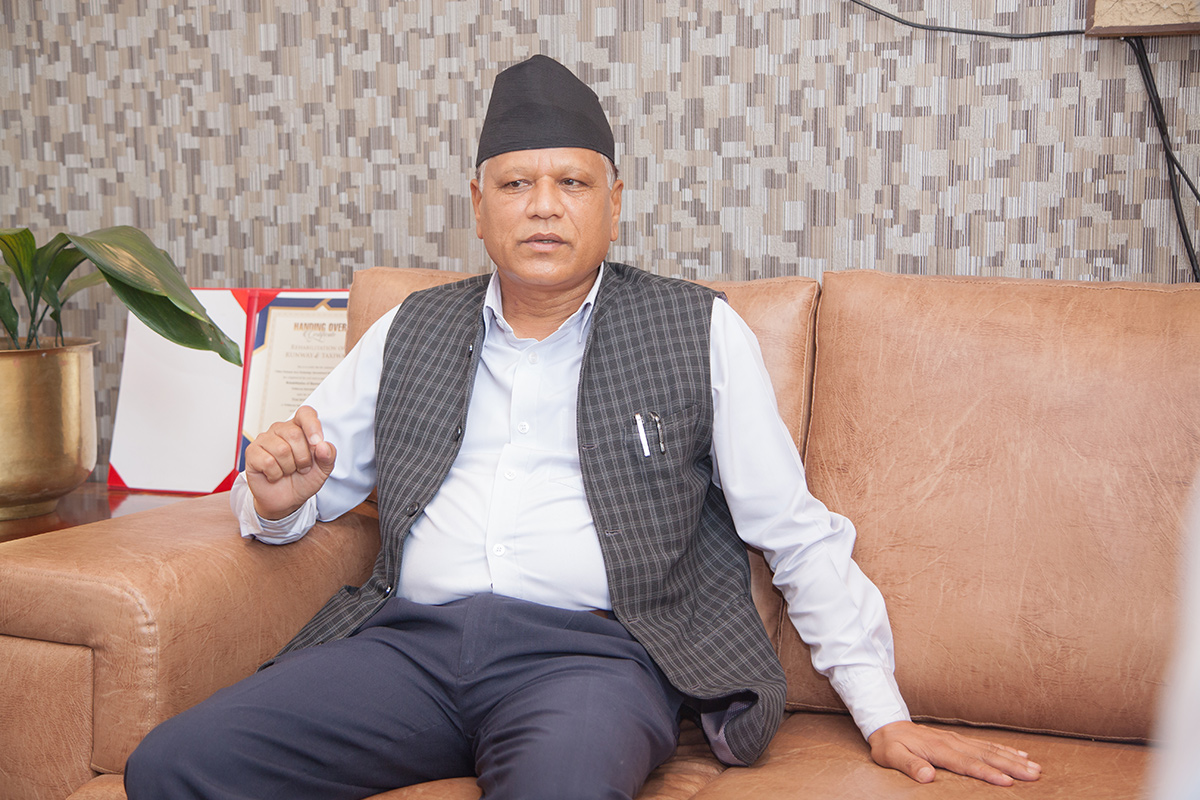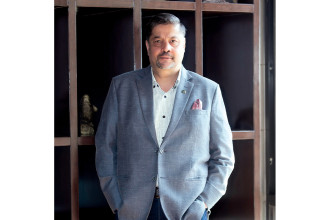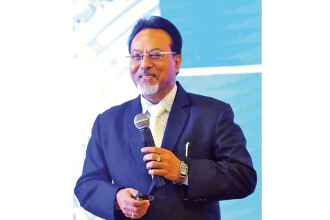
General Manager of Tribhuvan International Airport (TIA), Debendra KC, has been in the aviation sector for more than 30 years. His journey in the aviation industry started while he was preparing for his first year post-graduate examination. “A friend told me about an advertisement for air traffic controller training. I applied, got selected and did a one-year training course,” recalls KC. After that, he was temporarily appointment at TIA and soon got his first posting to Jomsom where he served for about two years. After that he served in Darchula and then at Balewa Airport in Baglung for three and a half years. When Balewa Airport closed in 1992, KC was posted to Jumla for about six years. He then returned to his hometown, Pokhara where he served as an Active Controller, Rated Controller and Training Officer for six years before becoming the Pokhara Airport Manager. From there, he was transferred to Kathmandu. At TIA, he was appointed as Airport Security Chief for two years and Aviation Security and Airport Operation Director for three years. He was thereafter relocated to Civil Aviation Authority of Nepal (CAAN) as Airport Security Director for two years after which he was transferred to handle the corporate sector as an Acting Deputy Director-General going on to become the Deputy DG. He then served as Academy Chief of the Civil Aviation Academy. “As the Academy Chief, I tried to organise maximum trainings so that we could produce two groups of air traffic controllers, two groups of rescue and fire-fighters. I ensured that a lot of trainings were based outside of Kathmandu in different areas of Nepal,” he shares. He focused also on trainings for security police and customs. “One of the significant achievements was when we acquired certification from the International Civil Aviation Organisation (ICAO) for our Academy as a trainer and full member certificate. I am proud of that,” he states. That meant that the Academy could organise trainings not only for Nepalis but also for foreign nationals.
After the Academy, he was transferred to CAAN Headquarter as the Deputy DG for Domestic Airports and then was reassigned to TIA as General Manager where has been serving for eight months.
In an interview with Dibesh Dangol from B360, Debendra KC talks about the current operations of TIA, relief measures for airline companies, plans and improvements at the airport, safety processes during the pandemic, Nijgadh International Airport and the EU ban. Excerpts:

Nepali flight carriers have been operating repatriation flights for now. Are regular flights on the pipeline anytime soon?
We have always wanted to extend the destinations of our national flight carriers. The cargo and repatriation flights that Nepali airlines have been operating are proof of our airlines and pilot capabilities to operate flights to those countries. Currently, the issue is being looked after by CAAN, the Ministry and the Government. The repatriation and cargo flights are being operated with coordination between the aviation authorities and governments of the respective countries. We are connected with ICAO, CAAN and the Ministry and have made a Standard Operating Procedure (SOP) on how to run the airport during this pandemic. We are working together with international airlines and domestic airlines but unfortunately, the condition is getting further challenging as the number of the affected people is increasing daily. Right now our concern is focused on the airport and handling the flights that bring rescued passengers.IATA has projected airlines will post record net loss of $84 billion this year and will remain in red in 2021. Are there any statistics collected by TIA or CAAN regarding the loss being borne by Nepali airlines companies due to the pandemic?
We are aware of this and have put forward this topic to CAAN as per enquires and suggestions of the airline companies, Airlines Operator’s Committee Nepal (AOCN) and Airlines Operators Association of Nepal (AOAN). We don’t have the exact numbers right now but have asked the airline companies to submit their data. As for TIA, the airport has been bearing a loss of Rs 750 million per month since the lockdown began even though we have been operating medical, cargo and rescue flights. Till date, we have sent more than 10,000 people to their respective countries and have even been operating domestic cargo and repatriation flights which are nominal sources for our income. Not just airline companies but airports are also facing a big loss due to the pandemic. We are trying to run the airport with whatever limited resources we have in the hope that when the pandemic ends, we will be back on full scale operations. We have already raised the concerns of airline companies and the organisations regarding IATA’s projection to CAAN and they been coordinating with the Ministry and the Government. CAAN has already put forward concerns regarding relief measures from the government. We have to wait for the government’s decision and the decisions issued by the government will then be coordinated with the airline companies.Though TIA has fulfilled social distancing requirements at the airport, its efficiency has been questionable.
Questions have been raised due to our small terminal and the high numbers of aircrafts. For social distancing requirements, we are making maximum available arrangements at the airport. The Covid 19 Crisis Management Committee (CCMC) is coordinating with our embassies abroad and the government of those countries to bring back Nepalis from abroad. We are operating a maximum of 10 flights a day to ensure we do not have long queues which goes against the social distancing norms. I think after the situation normalises and we are back to work on full scale, we may not have to be bound by the social distancing norms which isn’t possible in any airport in the world.Can you take us through the process every arriving and departing passengers will go through in both the domestic and international sections of the airport?
The SOP has been developed as per the special guidance from ICAO, International Air Transport Association (IATA) and CAAN. The departure starts from ticketing. Before issuing tickets, we have told the airlines, GSAs and travel agencies to ask passengers for two types of documents: health certificate certifying that the person is Covid 19 free and a form consisting of the passenger’s personal information like name, address and contact numbers. The passenger will then come to the golden gate (main gate) of the airport. No visitors are allowed during this pandemic situation and the taxi or bus capacity should be half of the total capacity. Doctors and security personnel at the gate will check the passenger’s documents and his/her temperature. If the passenger has medical issues and high temperature, s/he will be sent to the hospital or will be given medical assistance. If not, s/he can enter the airport terminal following the social distancing rules of the airport. The passenger will then go through the security check while entering the departure terminal. Inside the departure terminal, sanitizers have been placed at various points and wearing face mask has been made compulsory for all passengers and airport personnel. Then they will stand in a social distancing queue at the airline counter to check-in. We have placed barriers at the international and domestic airline counters so no direct contact is made between the airport staff and the passenger. After that, they will go to immigration following the social distancing queue and then will go to the sterile waiting hall which has been completed during the lockdown period. Alternate seating system has been exercised at the sterile hall for the current situation. The buses will then take the passengers to the aircraft and from there it is the responsibility of the aircraft authority. The arrival of the passengers is also the same. They will need to have two sets of documents saying they are free from Covid-19 and their personal information document. 40 passengers will come from the aircraft at a time, will go through a health desk managed by the Teku Hospital where they must provide those documents and then will go to the immigration process and custom area following the social distancing rules. At the immigration, the passengers will have to register the province they are from or want to go to. The busses waiting outside the arrival gate of the airport will take those passengers to the respective provincial quarantine zone established by CCMC.
Have other domestic airports also begun to implement social distancing requirements or is it just TIA that CAAN is concentrating on?
CAAN has already circulated the SOP to all the domestic airports as well depending upon the terminal and airport capacity. The main airports like Pokhara, Biratnagar and Bhairahawa have already started the social distancing requirements. The airlines have also issued their own SOPs to their customers. Both international and domestic airlines are very much aware of the social distancing and safety procedures they have to take and implement until this pandemic situation ends.What’s the reopening plans of TIA or CAAN going forward?
People were already wearing masks here in Kathmandu because of the pollution and now it has become more important. Wearing masks and following social distancing norms aren’t bad, but we can’t force it after things normalise. We can only advise passengers. I think the passengers themselves will realise the importance of wearing masks, using sanitizer and social distancing even after the pandemic ends and follow these procedures without our intervention or strict rules. The resuming of the airport solely depends upon the spread of the virus at the national and international level. The number of infected people is increasing globally and we must be aware of both the domestic and international situations. It also depends upon the government and the steps they want to take to open domestic and international travel. We can just send our suggestions to them, but the final decision regarding when and how to open the airports fully or phase wise depends upon them.What’s your view on the controversial construction of Nijgadh International Airport?
Being a biology student I know we must preserve nature, but as an aviation professional, Nijgadh International Airport is a very necessary project because Kathmandu Airport cannot be expanded anymore. We cannot have double and parallel runways here at TIA and whatever expansion work was possible has been done already. We recently completed the expansion of the runway by 300 metres, construction of two new parking bays to accommodate two wide-body aircrafts or three narrow-body aircrafts, and the construction of arrival walkway which directly connects the immigration to the taxi parking. Nijgadh International Airport is important because it is a full-fledged airport project and the place was selected as per the feasibility studies conducted by experts. The airport must be built so that Nepal and Nepalis can benefit from aviation and travel industry. Also, CAAN has already pledged to plant 6 million trees as replacement of almost 2.4 million trees that are needed to be chopped down for the construction of the airport with the help of Ministry of Forests and Environment in Bara and its neighbouring districts. I don’t think any aviation stakeholders are against the construction of the Nijgadh International Airport. Questions will be raised when any sort of development work is being done and we must welcome them openly. It is the responsibility of the concerned authorities to listen to the questions and answer accordingly with facts. Nijgadh airport is not just a prime project for CAAN or the Ministry. It’s a national pride project because the tourism industry is one of the high potential industries that can contribute largely to the economy of Nepal. We are poor but are rich in heart and resources. We should use our resources to develop our country. An example can be taken of Kulman Ghising. Thanks to him we don’t have the load-shedding problem anymore. If we can do the same thing in the aviation and tourism sector, it would be great for the economic development of Nepal.What’s the status of the EU ban?
EU ban is different. Nepal follows and is a member of ICAO, an organisation which has 193 member countries. We are following all those norms set by ICAO but are also continuously trying to improve on the suggestions from the EU. Nobody in this world is perfect. We are trying to have all safety and security measures in Nepali airlines and airports as suggested by ICAO and EU.What new improvements have been made at the airport besides social distancing markings?
We were able to complete the runway extension by 300 metres and have already started the new sterile waiting hall. We are demolishing the old waiting hall because of the safety zone concern raised by EU and ICAO. We have added two more parking hangers to accommodate two wide-body aircrafts. Currently, we are in the process of marking in those hangers. The lighting at the airport’s runway has also been improved. We are in the process of adding two more luggage belts to take the number of luggage belts to six. Making improvements at the airport is a never-ending project. Running the airport and increasing the facilities simultaneously is not an easy job because it creates disturbances in operation. But, the demand is increasing and we have to increase the physical facilities accordingly.
Published Date: July 14, 2020, 12:00 am
Post Comment
E-Magazine
RELATED Face 2 Face





